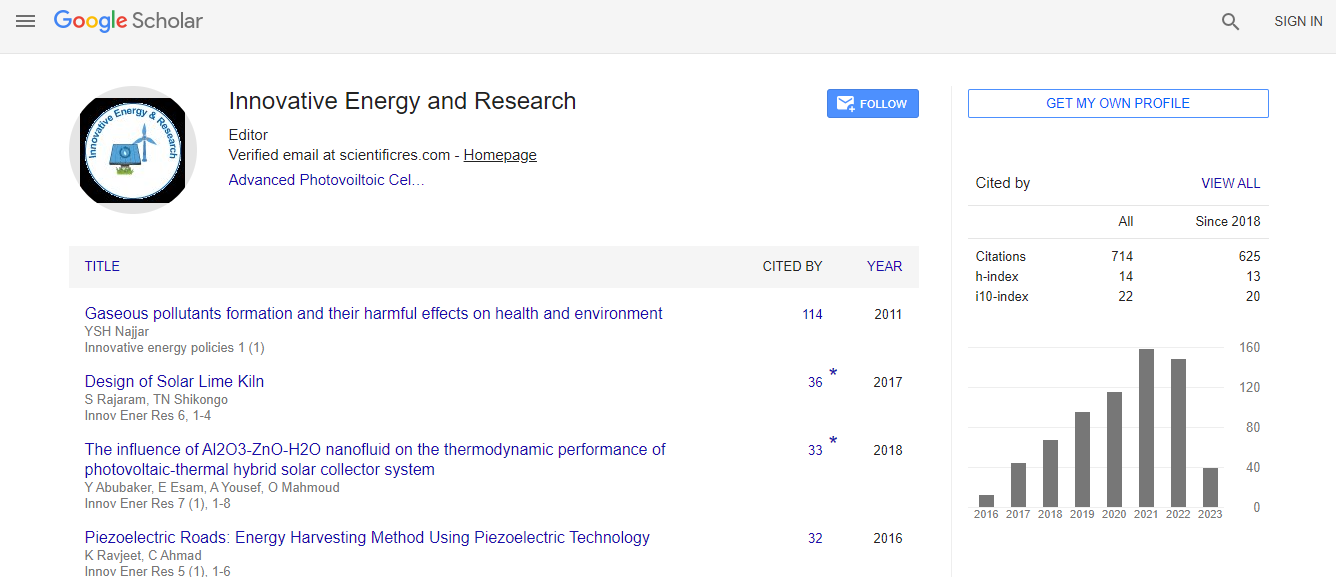Our Group organises 3000+ Global Conferenceseries Events every year across USA, Europe & Asia with support from 1000 more scientific Societies and Publishes 700+ Open Access Journals which contains over 50000 eminent personalities, reputed scientists as editorial board members.
Open Access Journals gaining more Readers and Citations
700 Journals and 15,000,000 Readers Each Journal is getting 25,000+ Readers
Google Scholar citation report
Citations : 712
Innovative Energy & Research received 712 citations as per Google Scholar report
Innovative Energy & Research peer review process verified at publons
Indexed In
- Google Scholar
- Open J Gate
- Genamics JournalSeek
- RefSeek
- Hamdard University
- EBSCO A-Z
- Publons
- Euro Pub
- ICMJE
Useful Links
Recommended Journals
Related Subjects
Share This Page
The ZnO based nanostructured anode materials for energy conversion applications @ LTSOFC
21st International Conference on Advanced Energy Materials and Research
Ghazanfar Abbas
Comsats University Islamabad, Pakistan
Posters & Accepted Abstracts: Innov Ener Res
Abstract
Introduction: Solid oxide fuel cells have got a countless consideration for the researchers in the field of energy conversion technologies due to their fuel flexibility and higher efficiency. Nanostructured materials have produced and great interest of researchers due to their vast applications in the field of chemistry, biotechnology, physics, medical science and material engineering etc. Now-a-day, the scientists attract their attention toward the nanomaterials for their use in energy conversion devices to overcome the energy crisis. Fuel cell is one of them which can fulfil energy demands. In a fuel cell device the chemical energy of fuel was converted into the electrical energy. It was composed of three components anode, electrolyte and a cathode. Among all other categories of fuel cells, solid oxide fuel cells (SOFC) were preferably used due to its reliability, flexibility of fuel, good efficiency, modularity, low emissions and environment friendliness.Experimental: In the present research investigation, two types of ZnO based anode materials with compositions Al0.1Mn0.1Zn0.8O (AMZ) and Al0.1Mn0.1Ni0.1Zn0.7O (AMNZ) were synthesized by solid state reaction. The phase confirmation and surface morphology of the synthesized materials were confirmed by the X-ray diffraction and scanning electron microscopic analysis, respectively. Electrical properties of the materials were also measured for energy applications.
Results and Discussion: The Scherer’s formula was applied to elucidate the particle sizes of proposed materials and found to be 52 and 61 nm for AMZ and AMNZ, respectively. The maximum conductivity of AMZ and AMNZ was found to be 4.4 and 5.2 S/cm, respectively. The values of activation energy calculated by Arrhenius plot were 0.21 and 0.25ev for AMZ and AMNZ, respectively. The fabricated materials showed both ionic and electronic conducting behaviour as confirmed by electrochemical impedance measurements. The AMNZ composition has higher value of open circuit voltage (1.01V) and power density (535 mW/cm2) in hydrogen atmosphere as compared to AMZ at 550°C indicating that the AMNZ can be used as promising anode material at low temperature for fuel cell applications. The results of measurements have been shown in figure 1
Conclusions: All these characterization results show that material is suitable for anode candidates in LT-SOFC and can be considered the new potential candidate as conventional one.
Biography
E-mail: mian_ghazanfar@hotmail.com

 Spanish
Spanish  Chinese
Chinese  Russian
Russian  German
German  French
French  Japanese
Japanese  Portuguese
Portuguese  Hindi
Hindi 
